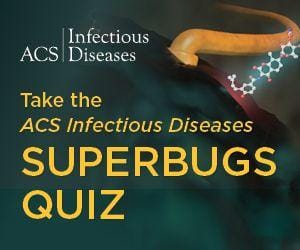Drug resistance and so-called “superbugs” are a growing concern among scientists, physicians, and health officials. A May 15 ACS Infectious Diseases webinar “Superbugs and Drug Resistance: Challenges in New Antibiotic Discovery” addressed the challenges posed by increasing amounts of antibiotic resistance and the difficulties researchers face in trying to discover new antibiotics and bring them […]


In the hour-long presentation, Deborah Hung, M.D., Ph.D., shared a clinical perspective and Eric Brown, Ph.D., shared a research perspective before taking audience questions on where we stand in the battle against drug resistance and superbugs. The following is a summary of their presentation. To hear the entire presentation and Q&A session and to see their presentation slides, register to watch a free recording of the webinar.
Real-World Clinical Examples of Antibiotic Resistance
Hung described a 66-year-old male patient she saw with non-insulin dependent diabetes who developed renal insufficiency and palpable purpura on his legs while living in India. During his treatment there, he developed a urinary tract infection then bacteremia with a multidrug-resistant Klebsiella pneumoniae, which was treated with escalating antibiotics. He was eventually transferred to the U.S., where blood cultures found Carbapenem-resistant Enterobacteriaceae (CRE), which was resistant to all standard antibiotics it was tested for.
However, additional special testing showed the bacterium was susceptible to Ceftazidime/avibactam and Tigecycline, even though tests in India showed it was not, Hung said. The patient was treated with a combination of Aztreonam and Avibactam, and was alive three years later.
This shows that “even the testing of [special antibiotics] can be variable, as these are not really benchmark susceptibility tests,” she said.
Hung gave four other examples of patients she has seen with drug-resistant superbugs:
- A 64-year-old male with a history of hypertension, type 2 diabetes, and chronic obstructive pulmonary disease who had Methicillin-resistant Straphylococcus aureus, better known as MRSA.
- A 21-year-old male with chronic myelogenous leukemia who developed Vancomysin-resistant Enterococcus (VRE) while in the hospital for a bone marrow transplant.
- An 86-year-old woman with recurrent urinary tract infections whose urine culture showed Extended Spectrum Beta-Lactamases produced by Escherichia coli.
- A 40-year-old woman admitted to the hospital for respiratory failure from influenza, and developed Pseudomonas aeruginosa in her sputum.
Clinical Challenges to Developing New Antibiotics
There are a number of challenges in discovering and developing antibiotics, including the genetic diversity of the bacteria researchers aim to treat, Hung said. If the goal is to treat a broad spectrum of bacteria, finding an antibiotic that works can be difficult. Additionally, specialists are hesitant to use new drugs even if they make it to market.
“We try to save them for the resistant extreme cases. We hope that the numbers are few. So in a sense, we’re trying to develop drugs that we hope we’ll never have to use,” Hung said.
The amount of time it takes to research and get approval for drugs is a challenge as well, Hung said. The median time for clinical testing and FDA approval is six years, and that’s after eight years of clinical testing.
Scientific Challenges to Developing New Antibiotics
Bacteria can be very diverse throughout different species. This makes it a challenge for researchers to find a commonality between them, so an antibiotic can be used to treat them. The limited permeability of cell walls also presents a challenge. Gram-negative cells are harder to treat, in part, because they have so many efflux pumps, which allow them to pump out antibiotics. Higher doses may be needed to overcome this challenge, but the human body can handle levels only so high before toxicity, Hung said.
How Can Researchers Fight Antibiotic Resistance?
Brown said he believes biochemical target-based efforts should only be used on the most validated targets. Also, one day pathogen-specific antibiotics may be a viable option, which would hold an advantage over antibiotics, as they would not harm the body’s microbiome. He also suggested that combination of strategies – two well-designed drugs – might be used to solve the problem posed by single-target resistance.
For cell-based approaches, many compounds inhibit bacteria growth, but researchers lack the tools to prioritize their work, Brown said. He said he thinks researchers should avoid conventional approaches, such as simple growth inhibition assays, standard microbiological media, and targeting one compound at a time, in favor of more creative thinking.
“My group’s been an advocate, and so have many others, for the idea that maybe we should think a little more creatively about what the targets are and the sort of assays that we do with screens,” Brown said.
Another problem is with antibacterial chemical matter. Commercially available chemical matter isn’t well suited to antibacterial drug discovery, and antibiotics don’t conform to the physical properties of conventional drugs, for example.
Brown said believes bold new approaches are needed in medicinal chemistry. “We need to better understand antibacterial permeability. We don’t have a good understanding now of the physical chemical properties are that allow a molecule to get into bacteria.”
Additionally, researchers should embrace natural product drug discovery, which has fallen out of favor. Most of the antibiotics in use have come from natural products, but researchers have avoided such a path recently. It may be time to rethink that, Brown said.
